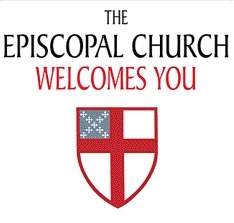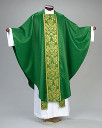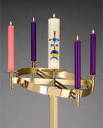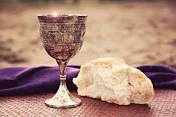

What to Expect at an Episcopal Service |
| Place of Worship | |
|---|---|
 |
As you enter the church, you will notice an atmosphere of reverence as your eye is drawn to the altar. On the altar, there are candles to remind us that Christ is the "Light of the world". You will be greeted and given a bulletin to guide you through the service. Take a seat wherever you wish. You will not be embarrassed when you visit our church; you will be a respected and welcome guest. You will not be singled out in an embarrassing way, nor asked to stand before the congregation nor to come forward. You will worship God with us. |
 |
There are various books in the racks in front of you:
|
| What Clergy Wear | |
|---|---|
 |
For the Eucharist, the priest wears an alb, which is a long, white robe with a cincture or rope around the waist. They also wears a stole, a narrow band of colored fabric, around their necks. The priest wears a chasuble (a circular garment that envelopes the body) over the alb and stole. The color of stoles, chasubles and altar coverings are changed with the church year seasons and holy days. |
| The Church Year | |
|---|---|
 |
The Episcopal Church observes the traditional Christian calendar. The beginning of the church year is the season of Advent, during which time we prepare for Christmas. The Christmas season lasts twelve days, ending with the feast of the Epiphany (January 6). Lent, the forty days of preparation for Easter, begins on Ash Wednesday. Easter season lasts fifty days, concluding on the feast of Pentecost. |
| The Service | |
|---|---|
| The principal service is the Holy Eucharist (Holy Communion). Another
service is Morning Prayer. Both Morning Prayer and Holy Eucharist have hymns, two Bible readings and a psalm,
which change every Sunday. The difference is that we take communion during the Eucharist service. You will find the services of the church beautiful in their ordered dignity, God-centered, and yet mindful of the nature and needs of people. The bulletin will lead you through the service. |
| Stand, Sit or Kneel? | |
|---|---|
 |
Visitors to the Episcopal church, are often confused as to when they should stand, kneel or sit. The simple answer is that we stand while praising God, sit for instruction and kneel to pray. We stand when singing and when reciting the Nicene Creed. We also stand during the Gospel, because the stories of Jesus' life and death are central to our faith. We sit during the sermon and the readings of the Old and New Testaments and the psalm and we kneel while praying. If you're not sure when to stand, just watch those around you. If you are uncomfortable kneeling, then just sit in the pew during the prayers. |
| Beginning of the Service | |
|---|---|
 |
The service begins with the processional hymn. The procession is led by
the cross and you may see people bowing to the cross as it passes by as a gesture of respect. The priest will say the collect, which is meant to collect our thoughts together as the concluding piece of the opening. |
| Liturgy of the Word | |
|---|---|
 |
A member of the parish will read the Old Testament, lead the congregation
in the reading of the psalm and then reads the New Testament. This is followed by the Sequence Hymn.
The priest will then read the Gospel. The sermon follows the Gospel reading and is meant to take what we have heard in the readings and connect those messages with our lives. After the sermon, we stand up and say the Nicene Creed, an ancient statements of faith used by most Christian churches. Following the Creed are the Prayers of the People from the Book of Common Prayer. These prayers are a series of petitions led by a member of the parish with a response by the entire parish. The petitions include prayers for the church, the world, the nation, those who are sick and those who have died. After the prayers we say the Confession. This is an opportunity to confess together the ways we have not loved God or others. We kneel for the confession as a sign of penitence. At the conclusion of the confession, the priest says the absolution, words reminding us that God forgives our sins. The priest then bids "the Peace". During the Peace we are ritually enacting our need to be in right relationship with one another before we go to communion. We do that by saying "Peace be with you". People may shake hands or embrace each other. |
| Liturgy of the Table | |
|---|---|
 |
The Congregation's financial offering for the support of the ministry of the church is collected at this time. A piece of music is played while the collection is being taken. The bread and wine we will use for Communion is brought to the Altar Table and the Priest sets the table for Communion. The offering plate is then brought forward and blessed by the priest. |
| Eucharistic Prayer | |
|---|---|
| At this point the service continues with what is commonly called the
"Lord’s Supper" or "Holy Communion". The term "Eucharist" means "Thanksgiving"
and we are giving thanks for the gifts God has given us and for the sacrifice of Christ. The prayer of the
Great Thanksgiving starts with a dialogue between the rector and assembly called the Sursum Corda
(literally "lift up your hearts"). The minister then praises God for God's action in our lives.
This selection concludes with us all singing the Sanctus, also known as "Holy, Holy, Holy". At this point, members of the congregation kneel. The prayer continues with a retelling of the story of the Last Supper. At one point the minister asks the Holy Spirit to descend upon the bread and wine and upon us. At the end of the Eucharistic Prayer, everyone prays the Lord's Prayer. The minister then breaks a piece of the bread, symbolizing Christ's body being broken for us. Once the bread and wine are sanctified the priest invites people to the table to share in God’s meal. | |
| Receiving Communion | |
|---|---|
 |
All Baptized persons are welcomed to come forward to either receive
a blessing or receive communion. The usher will help guide you when it is time to go forward. People generally
stand or kneel at the altar. If you do not wish to receive communion or a blessing, you are invited to remain
in your seat for a time of quiet prayer and reflection. At the altar rail, hold out your hands for the Priest to place a piece of bread in your hand. The priest's assistant will come with the cup of wine. There are several ways to receive Communion:
At the end of the service, everyone stands to sing the recessional hymn. After the hymn is sung, the priest will dismiss the congregation and send us out into the world. Once the service is concluded, all are invited to our parish hall for some socializing time and coffee. |
| Home Page | Top of Page |